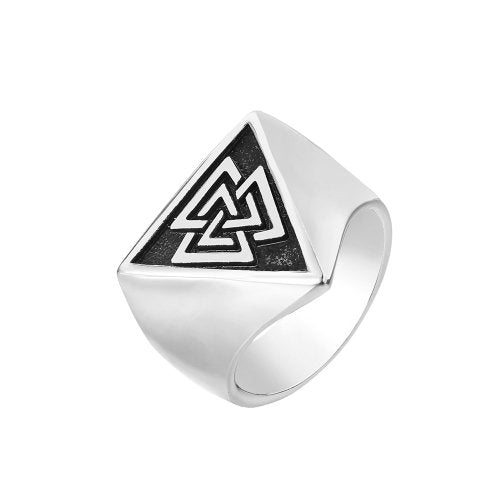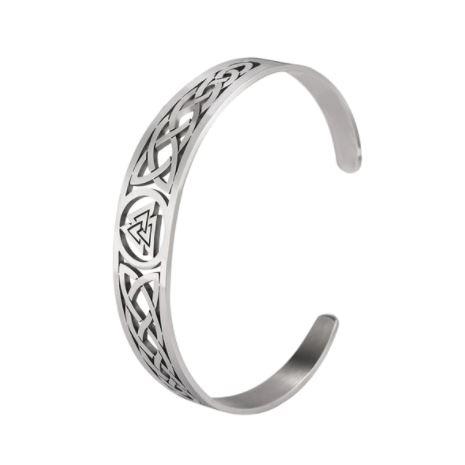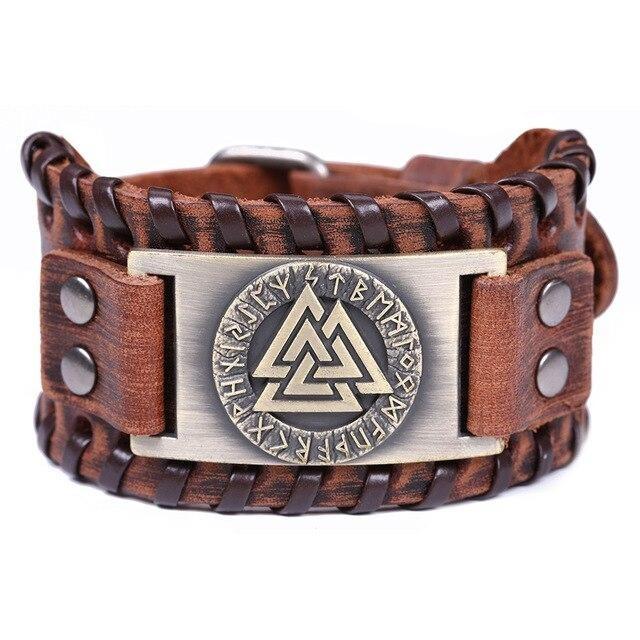Everything You Need to Know About the Valknut Symbol
Through certain magical rites, Viking-era shamans could control spirits and move the strands of fate according to their desires.
The powerful blessings they offered to the warriors of their clan allowed them to crush all their enemies and repel curses.
Among all the Viking symbols that these shamans left behind, there is one that stands out: the Valknut, also called Odin's triangle.
Contents :
Interpretations on the use of Valknut

What is Valknut?
The Valknut (pronounced val-knwot) is a symbol from Norse mythology representing three triangles nested within each other.
In reality, the name "Valknut" is a relatively recent word created in Norway which means " knot of slaughter ", or " knot of slain warriors ".
The Viking symbol it represents, on the other hand, dates back to ancient times and refers to the pagan cult of the dead.
It is most often engraved on runestones or tombstones alongside Odin or sacred Viking animals that historians can find the Viking triangle.
Nowadays, jewelry of this type is the most common.
Interpretations on the use of Valknut
A number of possible explanations for the origin of the Valknut have been suggested by historians.
Most believe he was related to Odin, a powerful and highly revered god in Norse mythology. According to the sagas, Odin is a powerful magician who is generally associated with wisdom, war, poetry, shamanism, magic and the dead.
Pagan Norse shamanism and magic were generally practiced only by women.
Yes, men who followed this practice were persecuted because such things went against Germanic social norms of the time.
Worshipers prayed, sang, and entered trances in mystical rituals in which they employed a variety of different Viking symbols.
Thus, they could reach a higher level of consciousness and travel through the Nine Worlds to glimpse the future and discover how to achieve their goals...

Interpretation of Valknut n°1: a means of traveling
According to the Vikings, the Nine Worlds are distinct domains that separate the different types of beings present in the universe: humanity, gods and goddesses, giants, ice, fire, elves and dead.
From a practical point of view, the Nine Worlds would be placed at the branches and roots of the world tree: Yggdrasil.
These different worlds are therefore rather well separated and it is very difficult, if not almost impossible, to move from one to the other.
A being, however, has the capacity to travel as he pleases. It's about Odin.
This donation would not come from nowhere. You may have guessed: it would indeed be the Valknut which would allow him to move like this.

Interpretation of Valknut n°2: the heart of a giant
According to some, Odin's triangle is rather linked to the heart of Hrungnir, a giant mentioned in the Edda of Snorri Sturluson (a book of Viking mythology).
Hrungnir was a giant and occupied the role of spirit of night, winter, darkness and tombs. It had a stone heart with three pointed corners.
Some therefore think that the Valknut could refer to him…
However, since the description is not very detailed, it is difficult to decide the question.
However, we know that if the Vikings particularly liked to use the Valknut in the form of an amulet, it was in particular to keep this symbol close to their hearts...

Interpretation of Valknut n°3: a mark of respect for the dead
Numerous examples of the knot of murder have been found on Nordic tombs all over Europe.
This Viking symbol appears for example on a commemorative stone found on the Swedish island of Gotland, or on objects linked to funeral rites in the Oseberg burial ship in Norway.
Similar symbols also appear on Anglo-Saxon funerary urns and on the funerary tools of some Germanic peoples closely related to the Vikings.
All this seems to confirm the association between the symbol of the Valknut and a certain respect for the dead.

Interpretation of Valknut n°4: symbol of fallen warriors
More than simply associated with death, it seems that Odin's triangle was associated with the death of warriors.
Indeed, the Valknut almost always appears alongside images and symbols of the Viking god Odin. Among all his responsibilities was that of war. It was therefore he who was responsible for granting victory… or defeat.
The Vikings also believed that warriors who fell bravely in battle were taken by Odin's servants, the Valkyries, to live in Valhalla.
There they were supposed to drink, fight, and have fun until Ragnarok arrived, the final battle in which they would be called to fight again, this time alongside the gods.

The meaning of Valknut
Now that you know its different interpretations, let's look at the meaning of the knot of occis.
Some scholars have suggested it was a symbol of reincarnation, others believe it was to protect dead souls from evil.
As the nine points of the triangle have been associated with the nine worlds of Norse mythology, and the three interconnected triangles are believed to reflect the connection between Earth, Heaven and Hell, the Valknut has also been associated with magic and travel. between worlds.
Personally, I think the Valknut should be associated with Valhalla.
In fact, this only refers to his connection with death, but also to that with Odin and the warriors.
The Vikings believed that no matter how much nobility you demonstrated during your life or how courageously you faced life's trials, you had to die in battle in order to be taken to Valhalla.
This created a strange custom: it was not unusual for the Vikings to stab those suffering from illness while placing a sword in their hands in order to deceive Odin and his Valkyries.
With this in mind, the Valknut is a Viking good luck charm that can easily be used as part of magical rituals seeking to help the deceased reach the afterlife.
This would also explain the connection Odin's triangle has with the heart of the giant Hrungnir. It is entirely possible that, given his qualities as guardian of darkness and the grave, this character had a role to play when it came to taking the spirits of the dead to other forms of life than no one would want to know.
The knot of killings could therefore well act as a Viking symbol of protection supposed to protect us from the visit of Hrungnir.

A powerful magical symbol
Through trance, singing and perhaps even sexual magic, the practitioners of magic and shamanism of the Viking civilization are believed by some to have the ability to influence the minds of people and to weave the threads of destiny. according to their desires.
Their mighty blessings strengthened their warriors for battle, and their curses crushed their enemies.
Among the many traces that these mystics left behind them, the Valknut is found in a truly impressive quantity.
A number of hypotheses have been put forward as to how the Vikings used it. However, no certainty on the question could really be established. This is often the case for such ancient and powerful symbols.
As we saw earlier, the Valknut is associated with the god Odin, a central character in Norse mythology. Revered and powerful, his name is sometimes translated as “the Master of Ecstasy”. This tells us a lot about the mystical character of this divinity.
Indeed, Odin was further associated with magic, wisdom and shamanism. Many legends and sagas show us that he had, for example, the ability to control the minds of men, and sometimes even the matter of our world.
Pagan Norse magic, sometimes called Seidr (pronounced sëi-dir), was generally practiced only by women.
Men who followed this practice were persecuted because such things went against Germanic social norms of the time.
In short, the faithful prayed, sang and went into trance collectively during rituals dedicated to Odin. We know that the Valknut, among other Viking symbols, was used there, but we don't know exactly how…

Traces of the Valknut in archaeological remains
The Valknut is therefore a very special symbol of Viking magic.
The Ancients gave it such a place that we find it today on a whole bunch of remains and monuments dating from the Viking era and, more broadly, from a time when the time was still pagan.
Runestones, rings, ships, temples and other archaeological sites show us the Valknut as a powerful symbol associated with the most important gods (notably Odin).
Here is a list of some notable places where you can see it:
- The Stora Hammars Stones, enormous monoliths standing near Lärbro in Sweden, show us wild warriors fighting alongside the Valknut.
- The Tängelgårda runestone, also located on the island of Gotland in Sweden, is painted with gods, fighters and Viking symbols (including the Valknut)
- The hogbacks, standing stones erected in England by the Viking invaders from the 10th to the 12th century, are also often marked with the famous murder knot.
- The Oseberg Ship, a primitive longship found near Tønsberg in Norway, has the Valknut carved into its wood.

The Valknut tattoo
Getting a Valknut tattoo is an excellent idea for anyone who loves Nordic mythology, triangles or simply for those who find that one of the meanings given to the Vaknut corresponds to them.
Although it may look like a simple symbol made up of three intertwined triangles, the Viking knot often means much more than that to those who get it tattooed.
Valknut tattoos are actually not new! The Vikings already tattooed it on their skin.
It was among warriors in particular that this practice was most widespread (it is not for nothing that it is called the “slain warriors’ knot”, remember?).

Reason to get a tattoo of Valknut No. 1: a tribute to the departed
Most of the time, when someone gets a tattoo of the Valknut, they give it a rather classic meaning. This mark forever engraved on the skin can, for example, honor a deceased friend or family member.
In particular, many soldiers choose to have the knot of killing tattooed in tribute to one (or sometimes unfortunately several) of their fallen comrades.
Additionally, Odin's triangle can also symbolize reincarnation. Many people see its interlocking triangles as signs of the interconnection of different lives.
If you believe in reincarnation or just like the idea, then getting a Valknut tattoo could be a very cool way to show it off.

Reason to get a Valknut No. 2 tattoo: a nod to your roots
Many people get this Viking symbol tattooed to show the pride they have in their Scandinavian or Nordic heritage. In these cases, the knot of killings will often be mixed with other Viking images.
If you want to discover the main ones, here is an in-depth guide to the Viking symbol in all its splendor !
In short, this lucky charm can be quite interesting to show your attachment to Nordic mythology.
As its pattern is relatively simple, the Valknut is also a good idea for pagans whose purses are not necessarily very full.

Conclusion
Today, the Valknut is widely associated with Norse paganism and Viking culture in general. ..but also with modern German. Indeed, this symbol has been used as a logo by many companies, and even as an emblem by the German national football team.
Perhaps one of the reasons the Valknut is so popular is because it is fascinating.
Indeed, it still remains very mysterious. The meanings that we can bring to it are multiple and its origin remains unclear.
However, this brings a huge advantage : for the modern Viking that you may be, it leaves plenty of room for personal interpretation.
So, what do you think? What does the Valknut mean to you?
Lucky charms presented:

Engraved Valknut Amulet
See more
Valknut Ring
See more
Stylized Nordic Valknut Bracelet
See more
Leather Bracelet Decorated with the Valknut
See more

